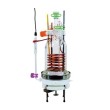Overview
The Flexcell™ (Part No. 992-9) is a two-piece, 1 L cell with a flooded gasket. It is made up of a PTFE base with three ports and two o-ring seals, and a glass bell top with 7 ports (four #7 Ace-Thread, 2 24/40 standard taper, 1 SJ 35 ball joint). A cross section of the flooded gasket seal can be seen below.

The flat specimen is mounted under the flooded gasket beneath the PTFE base. The three ports are for the flooded gasket DI water source, a temperature probe, and the reference electrode luggin all positioned near the specimen.
The ports of the glass bell top accommodate a graphite counter (Ace #7), a gas dispersion tube (ST 24/40), an available wand stirrer (center ST 24/40) and an internal, PTFE coated copper coil (2x Ace #7). The copper coil is used to provide chilling while heating is provided by a wrap-around heating mantle. The remaining two ports (1 Ace #7 and the ball joint) are available to accommodate additional needs a researcher may have.
A stirrer is highly recommended. In the absence of convection, the flooded gasket can produce a barrier, corrosion free zone over the entire surface of the electrode. Only very slight stirring is necessary to disrupt this and keep the electrolyte/electrode interface constant for the duration of the experiment. Gamry carries a stirrer and stirring rod kit.
If you are performing temperature controlled experiments it can be useful to have a circulator providing the chilled water. In addition to a circulator we recommend a three-way value by Asco (no. 8320G176) that is controlled by the TDC5 to switch in the chilled water.
Recommended Uses
Critical Pitting Temperature
Researchers wanting to study critical pitting temperature need to eliminate crevice corrosion. The Flexcell™ is an absolute necessity for this. When used in conjunction with the CPT110 Critical Pitting Temperature software and a TDC5 Temperature Controller or any other lab grade precision temperature controller, the system becomes a very useful and powerful tool for studying localized corrosion.
Corrosion Studies
Standard corrosion experiments (DC and AC) will work well with any of Gamry’s flat cells, including the Flexcell™. However, samples that are highly susceptible to pitting, and for studies that aim to study pitting absent crevice effects—especially under conditions designed to accelerate pitting—are much better suited to the Flexcell™.







